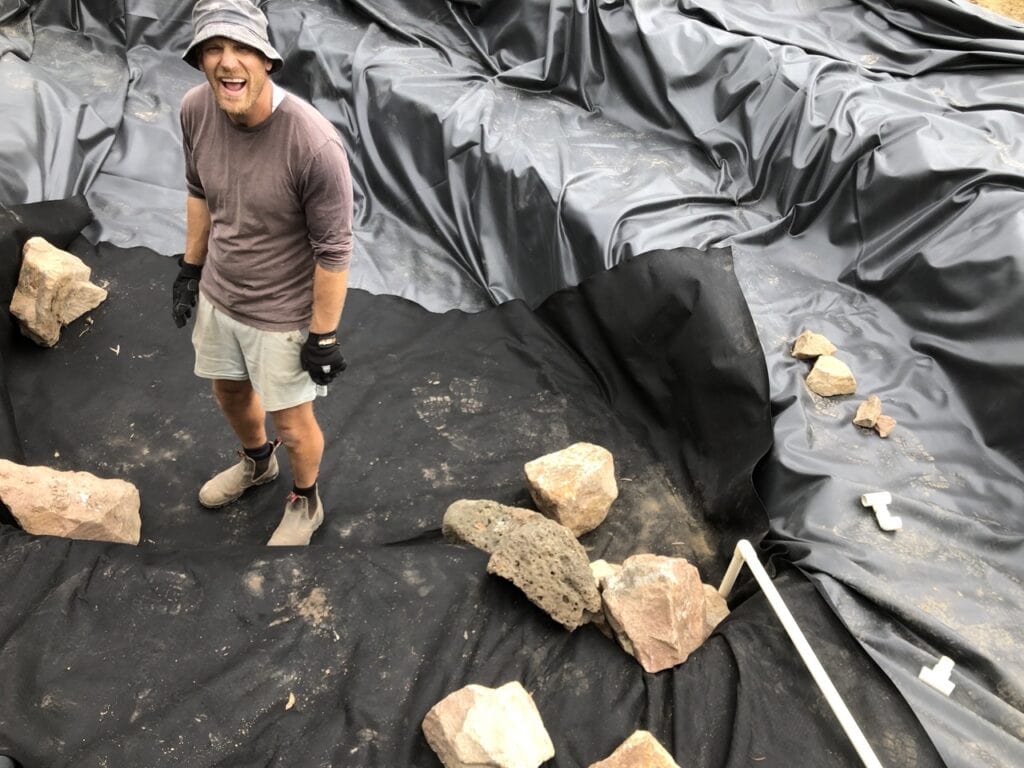Maintaining a beautiful fish pond doesn’t have to mean constant cleaning and interference. My 5-year-old courtyard pond is a good demonstration on how minimal maintenance and a balanced ecosystem can create a thriving aquatic environment.
So, let me share why over-cleaning can do more harm than good and how my setup embraces nature to keep things running smoothly.
Why Over-Cleaning Can Be Harmful
Excessive cleaning can disrupt the delicate balance of your pond’s ecosystem, which relies on a variety of microorganisms and natural processes to function properly.
Destruction of Microscopic Life: The muck and sediment that accumulate in your pond may appear dirty but are home to beneficial microorganisms like bacteria, algae, and other microscopic life forms.
These organisms play a crucial role in breaking down organic materials such as fish waste, uneaten food, and decaying plant matter.
Removing this layer entirely can starve your pond of these natural cleaners, leading to a buildup of waste and poorer water quality.
Disruption of Natural Filtration: Many ponds develop a biological filtration system within their rocks, pebbles, and sediment.
Beneficial bacteria colonise these surfaces, processing harmful substances like ammonia and nitrites into less toxic forms such as nitrates.
Over-cleaning can disturb or wash away these colonies, forcing your pond to rely more on artificial filtration and making it harder to maintain balance.
Loss of Biodiversity: Ponds host a range of small organisms, such as insect larvae, snails, and algae-eating microorganisms, that contribute to the ecosystem’s health.
Vacuuming or removing sediment too aggressively can wipe out these populations, upsetting the natural food web and leaving your pond more prone to issues like algae blooms.
Increased Algae Growth: Sediment and muck help lock away nutrients that would otherwise fuel algae growth.
By removing too much sediment, you release these nutrients back into the water, creating a fertile environment for algae blooms that can cloud the water and deplete oxygen levels.
Stress on Fish and Plants: Over-cleaning can temporarily destabilize water chemistry, causing sudden changes in parameters like pH and oxygen levels.
Fish and plants thrive in stable environments, so these fluctuations can stress them and make them more susceptible to disease.
My Pond Setup
My pond is lined with a durable liner, covered with rocks and pebbles. Marginal plants grow directly in the pebbles, while water lilies are planted in baskets with nutrient-rich, clay-based substrates to encourage flowering.
The filtration system relies on a single pump housed in a DIY skimmer.
The skimmer is made from an old bucket, the skimmer uses coarse filter sponges to trap debris and prevent pump clogging. This simple design keeps maintenance to a minimum while clearing surface debris and improving water clarity.
Water is pumped from the skimmer into a DIY bog filter, constructed from a repurposed olive drum.
Here’s a video on how the DIY skimmer was built and how it works:
The bog filter is filled with rocks and pebbles—larger at the base and smaller at the top—to support beneficial bacteria growth.
These bacteria break down waste, process nutrients, and reduce algae growth naturally, keeping the water clear.
Key features of the bog filter include:
- Sediment Trapping: Larger rocks at the base capture fine sediment.
- Breather Pipe: Prevents siphoning back into the pond if the pump stops.
- Clean-Out Point: Allows for easy removal of accumulated solids.
After filtering, the water flows back into the pond through a small stream and waterfall, oxygenating the water and supporting the ecosystem.
Here’s a video on how this type of bog filter is constructed:
How Minimal Maintenance Works on my Pond
By avoiding over-cleaning, I allow nature to handle much of the pond’s upkeep. Here’s how I keep maintenance minimal:
- Surface Skimming: The skimmer collects leaves, debris, and proteins from the surface, enhancing water clarity.
- Filter Cleaning: The skimmer sponges only need rinsing every few months.
- Bog Filter Flushing: Periodic flushing removes fine solids without disrupting beneficial bacteria.
Here’s a good overview video on how this entire pond was constructed:
Embracing a Natural Ecosystem
I don’t feed the fish—they thrive on the organisms naturally present in the pond. The rocks, pebbles, and plants create hiding spots and habitats for various life forms, from algae-eating organisms to tadpoles and dragonfly larvae.
Instead of vacuuming sediment frequently, I collect it in shaded tubs, allowing these creatures to complete their life cycles.
Key Takeaways
- Avoid Over-Cleaning: Letting sediment accumulate supports beneficial bacteria and promotes biodiversity.
- DIY Filters Are Effective: Simple, homemade systems reduce maintenance and cost while keeping your pond healthy.
- Nature Knows Best: Allowing your pond to function as an ecosystem minimises the need for interference.
In my yard I have many ponds so it’s essential for me that they be low maintenance. Over the years I’ve developed a system that allows me to build low maintenance ponds and achieve clean, clear water every-time!
If you would like to see that system check out the formulas I use to build my ponds. I hope this was helpful. Thanks for reading.

Blueprint I use to build my ponds
- All the numbers I use to design my ponds, delivered straight to your inbox
- These formulas have helped people all over the world build beautiful, low maintenance ponds, without spending a fortune.
- Access to a private community of like minded people and a chat bot that loves answering pond related questions.

